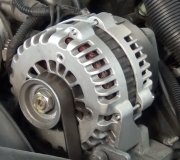Yup. As a former instructor, it was important to me to use correct terminology in the classroom. The "AC generator" was developed by Chrysler for use in 1960 models, and they copyrighted the term, "alternator". Of course everyone knows what you mean when you say "alternator", but to be correct, everyone else uses the term "generator" in their service literature. Not many people catch this. GM had their first AC generator design in 1964 models, and Ford had theirs in '65 or '66.
With the older DC generators, the high output current was taken off the spinning armature and through the brushes. You were lucky to get 30 amps through those sad brushes. The AC generator feeds the spinning field coil with only a little puny three amps when charging wide-open, and often less than one amp during normal operation. That is real easy to do. The high output current, today as high as over 160 amps, comes off the stationary "stator" coil, and through nice fat wires and no brushes.
Be aware too that GM has had a real big problem with their generators since they redesigned them for the '87 model year. Due to their design, they develop a lot of huge voltage spikes that can damage the internal diodes and voltage regulator, and interfere with computer sensor signals. The battery is the key component in damping and absorbing those spikes, but as they age and the lead flakes off the plates, they lose their ability to do that. That is a real common cause of repeat generator failures. In fact, a lot of people go through four to six replacement generators in the life of the vehicle. To reduce that number of repeat failures, always replace the battery at the same time that you replace the generator, unless it is less than about two years old. If it still tests fine, as yours did, it is okay to use that battery in an '86 or older GM car. Those had, in my opinion, the world's second best generator design.
My assertion that your generator has worn brushes is based on the symptom of intermittent operation, but that can also be caused by an intermittent voltage regulator. On GM models the intermittent regulator is much more common, after being hit repeatedly with those voltage spikes. On all other brands, intermittent brushes are much more common. The clue to worn brushes is the problem will act up more and more frequently over the next few weeks or months, and for longer periods of time. An intermittent regulator will usually suddenly totally stop working.
There are repair kits available for these generators, but once you manage to get one apart, there is no way to test the regulator, no way to know if the brushes were making solid contact, and the thin metal tabs on the diode block usually get broken off in the disassembly process. With the frustration involved in getting it apart, you don't want to risk reusing a bad part, so you'll want to replace all of them. They also have had problems with bearings failing, then the rotor locks up, so those kits come with new bearings too. Given the unknowns, the inability to perform the same tests you could on the older models, and the cost of the repair parts, you're better off buying a professionally-rebuilt unit with a warranty.
Often there are multiple generators available for your truck with different maximum output current ratings. Stick with what your truck came with. If you don't know what that is, the full-load output current test can show that when the system is working. You'll either find it puts out very close to the maximum current it is rated for, or exactly one third of that if it has one failed diode. You lucked out in that there is just one size listed for your engine size. That is a 150-amp unit. The larger engine uses a 145-amp generator. If there had been an optional larger generator available and you put that on your truck, you would not notice anything different. They all develop exactly the amount of current needed to meet the demand, and no more, however, they will produce their maximum current they are designed to deliver when under the full-load output current test. There will be a fuse-link wire or a bolted-in fuse in that output circuit, and the value of that fuse is selected at the factory to match the generator they installed. When you replace the generator with a larger one, during that full-load test, it can develop more current than the fuse link can handle. That is the only time a problem can develop when switching to a larger generator.
Monday, February 18th, 2019 AT 6:03 PM


